Feline Itchy Skin, Help!

Is your feline constantly scratching, licking, biting at the skin, or rubbing up against objects? If so, it could be suffering from an itchy skin disease, a very common problem found in felines and characterized by behaviors focused on relieving the itch. The first step to take is to carefully look at the skin and the hair coat.
How to examine the skin and hair coat of a feline:- Run a comb or bristle brush against the lay of the hair to expose the skin
- Check the appearance of the skin
- Look to see if there is any residue on the comb or brush.
- Redness
- Swelling
- Rash
- Bumps
- Flea detritus
- Insects
- Scabs
- Scaly flakes
- Allergic contact dermatitis: Red and itchy bumps, inflamed skin at the site of contact, a rash that may spread beyond the area of contact
- Chiggers: Itching with skin irritation between toes, around ears and mouth
- Contact dermatitis: Red, itchy bumps, inflamed skin at site of contact, may be caused by rubber or plastic food dishes
- Ear mites: Head tilting and shaking, scratching at the ears, brown, waxy material in ear canals
- Flea allergy dermatitis: Red, itchy bumps over the base of tail, back of rear legs and inner thighs, itching continues after fleas have been killed
- Fleas: Itching and scratching along the back, around tail and hindquarters, may see fleas, flea feces and eggs
- Food allergy dermatitis: Severe itching over the head, neck and back, swelling of eyelids, reddened ears, possible hair loss and oozing sores
- Inhalant allergy: Small bumps and crusts around the head, neck and back beneath hair coat, may have symmetrical hair loss over body
- Lice: Look for nits that look like white grains of sandy material attached to the hair, may have bare spots where hair has been rubbed off
- Maggots: Soft-bodied, legless fly larvae found in matted fur or open wounds
- Scabies: Intense itching around the head, face, neck, and edges of the ears, hair is rubbed off, typical thick gray to yellow crusts on skin
- Ticks: Often found around the ears, along the back, between the toes
- Walking dandruff: Large amounts of dry, scaly, flaky skin over the neck, back, and sides, mild itching
This partial list shows feline skin ailments can be caused by allergies, parasites, irritations, or internal diseases. Your veterinarian is trained to recognize the symptoms and diagnose a remedy that will relieve the itchiness before the animal suffers hair loss, wounds, or bacterial infections.
Would you like to see more information regarding feline skin health? Visit our products page and learn what can help your itchy feline!
Careers
Are you looking for a place to let your talents shine? At Covetrus, we help our practitioner customers better serve their patients and take pride in providing the best customer experience possible. Search our open positions to see our available opportunities.
Newsletter
Stay current with what’s going on with Covetrus, subscribe to receive our newsletter and email communications. Subscribers will receive the latest information in practice management, sales and marketing, animal health, and more.


Leave a comment